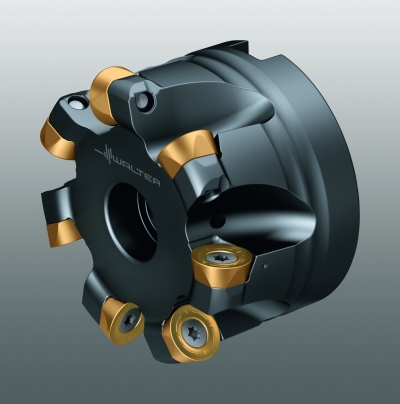Contact Details

Walter has expanded its Tiger·tec Gold line of indexable inserts with the addition of the WMP45G grade made specifically to handle the challenges of turbine blade machining. The new WMP45G grade, available as round indexable inserts for the F2334R copy milling cutter, is for facemilling and copy milling of martensitic and austenitic stainless steels.
The Tiger·tec Gold line’s combination of a heat-resistant yet tough substrate with a TiAIN coating layer sets the benchmark in ultralow-pressure CVD coating technology. The technology enables Tiger·tec Gold to boost tool life, increase productivity and provide greater process reliability. The new grade is available in three different geometries – D57, D67 and F67 – to suit the stability of various machines, clamping arrangements and workpiece geometries.
The performance of the WMP45G is as unique as the grade itself: This new grade boosts the number of turbine blades usually milled in multitasking machines by 20 to 50 percent. In addition, it also boasts the well-known benefits of the Tiger·tec Gold grades, including good wear detection. Walter recommends using the WMP45G when cutting parameters are critical and long tool life is needed. As a result, this new turbine blade grade is especially beneficial for users who work with high volumes and require high machine output.
Related Glossary Terms
- chemical vapor deposition ( CVD)
chemical vapor deposition ( CVD)
High-temperature (1,000° C or higher), atmosphere-controlled process in which a chemical reaction is induced for the purpose of depositing a coating 2µm to 12µm thick on a tool’s surface. See coated tools; PVD, physical vapor deposition.
- facemilling
facemilling
Form of milling that produces a flat surface generally at right angles to the rotating axis of a cutter having teeth or inserts both on its periphery and on its end face.
- gang cutting ( milling)
gang cutting ( milling)
Machining with several cutters mounted on a single arbor, generally for simultaneous cutting.
- milling
milling
Machining operation in which metal or other material is removed by applying power to a rotating cutter. In vertical milling, the cutting tool is mounted vertically on the spindle. In horizontal milling, the cutting tool is mounted horizontally, either directly on the spindle or on an arbor. Horizontal milling is further broken down into conventional milling, where the cutter rotates opposite the direction of feed, or “up” into the workpiece; and climb milling, where the cutter rotates in the direction of feed, or “down” into the workpiece. Milling operations include plane or surface milling, endmilling, facemilling, angle milling, form milling and profiling.
- milling cutter
milling cutter
Loosely, any milling tool. Horizontal cutters take the form of plain milling cutters, plain spiral-tooth cutters, helical cutters, side-milling cutters, staggered-tooth side-milling cutters, facemilling cutters, angular cutters, double-angle cutters, convex and concave form-milling cutters, straddle-sprocket cutters, spur-gear cutters, corner-rounding cutters and slitting saws. Vertical cutters use shank-mounted cutting tools, including endmills, T-slot cutters, Woodruff keyseat cutters and dovetail cutters; these may also be used on horizontal mills. See milling.
- multifunction machines ( multitasking machines)
multifunction machines ( multitasking machines)
Machines and machining/turning centers capable of performing a variety of tasks, including milling, drilling, grinding boring, turning and cutoff, usually in just one setup.
- stainless steels
stainless steels
Stainless steels possess high strength, heat resistance, excellent workability and erosion resistance. Four general classes have been developed to cover a range of mechanical and physical properties for particular applications. The four classes are: the austenitic types of the chromium-nickel-manganese 200 series and the chromium-nickel 300 series; the martensitic types of the chromium, hardenable 400 series; the chromium, nonhardenable 400-series ferritic types; and the precipitation-hardening type of chromium-nickel alloys with additional elements that are hardenable by solution treating and aging.











 PRODUCTS
PRODUCTS

